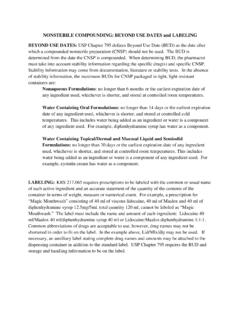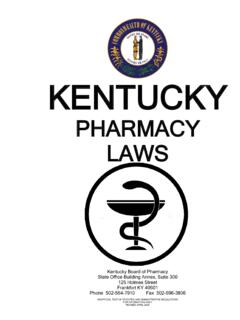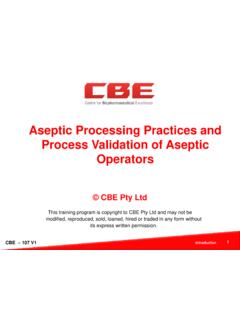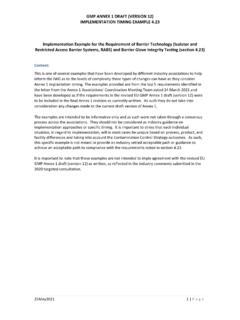Transcription of Broad Comparison of USP 797: Sterile Compounding
1 9/26/20191 Broad Comparison of USP 797: Sterile Compounding JUNE 2008 VERSION VERSUS JUNE 2019 VERSIONSEPTEMBER 25, 2019 BOARD OF PHARMACY MEETINGS ummary Easier to read More clear about documentation requirements and processes Have designated person (DP) No risk categories was low, medium, and high Now Category 1 or Category 2 compounded Sterile preparations (CSP) USP 800 incorporated for Sterile Compounding with hazardous drugs Radiopharmaceuticals have own chapter, USP 825 No appendices with sample forms Training is done every 6 months9/26/20192 Summary CAI and CACI in SCA may only be used for Category 1 CSPs 12 hour BUD room temperature or 24 hour BUD refrigerated CAI and CACI in Compounding suite may have longer BUDs Pharmaceutical Compounders (PC) in SCA may only be used for Category 1 CSPs 12 hour BUD room temperature or 24 hour BUD refrigerated PC in ISO 8 room may have longer BUDs Anteroom not required ISO 8 environment required to have 20 Air Changes Per Hour (ACPH) Sink may be outside ante room in a clean spaceSummary Surface sampling must be done monthly Must attempt to analyze growth to the genus only if out of limits Cleaning and disinfecting more clearly defined Requires use of sporicidal agent monthly Requires Master Formulations, exception CSP for 1 person Requires Compounding Records BUDs changed with some extended but a max regardless of stability Single Dose Vials may be used up to 12 hours as long as storage requirements are maintained 9/26/20193 Designated Person (DP)June 2008 No mention of designated person (DP) 201 KAR 2.
2 076 Section 3 Requires PIC to be knowledgeable and oversee compoundingJune 2019 Requires designated person (DP) to oversee USP 797 Scope: Types of Compounded Sterile Preparations (CSPs) ClarifiedJune 2008 Irrigations for wounds and body cavitiesJune 2019 Irrigations for internal body cavities Any space that does not normally communicate with the environment outside of the body such as the bladder cavity or peritoneal cavity Irrigations for the mouth, rectal cavity, sinus cavity are not required to be sterile9/26/20194 Preparation Per Approved LabelingJune 2008 CSPs include: Manufactured Sterile products that are either prepared strictly according to the instructions appearing in manufacturers' approved labeling (product package inserts) or prepared differently than published in such 2019 Preparing a conventionally manufactured Sterile product in accordance with the directions in the manufacturer s approved labeling is out of scope of this chapter only if.
3 The product is prepared as a single dose for an individual patient, and The approved labeling includes information for the diluent, the resultant strength, the container closure system, and storage Bag and Vial SystemJune 2008 Follow manufacturer s instructions for handling and storing systemsJune 2019 Docking and activation of system for immediate administration Not considered Compounding Docking for future activation and administration Is considered Compounding Use manufacturer beyond use date (BUD)9/26/20195 Immediate UseJune 2008 For emergency or immediate administration CSP involves not more than 3 different Sterile products Compounding is continuous and takes no more than 1 hour Administration begins not later than 1 hour following the start of the preparationJune 2019 For direct and immediate administration CSP involves not more than 3 different Sterile products Administration begins within 4 hours of start of preparation CSP CategoriesJune 2008 Low with 12 hour BUD Low Medium HighJune 2019 Category 1 12 hour BUD room temperature, or 24 hour BUD refrigerated Compounded in Segregated Compounding Area (SCA) Category 2 Have a BUD longer than Category 1 CSPs9/26/20196 TrainingJune 2008 Every 12 months Cleaning Didactic examJune 2019 Every 12 months.
4 Cleaning and disinfecting Calculations, measuring, mixing Use of equipment Documentation of Compounding process Principles of HEPA in ISO 5 Proper use of PEC Principles of movement of materials and people Written or electronic examTrainingJune 2008 Low and Medium Risk 12 months Hand hygiene and garbing Observed aseptic technique Media fill test (MFT) Gloved fingertip test (GFT) Initially, 3 times, 0 growth After MFT, up to 3 growths High risk 6 months Same as aboveJune 2019 Compounding personnel 6 months Hand hygiene and garbing Observed aseptic technique Media fill test (MFT Gloved fingertip test (GFT) Initially, 3 times, 0 growth After MFT, up to 3 growths9/26/20197 Personal HygieneJune 2008 Cannot compound if have: Rashes Oozing sores Conjunctivitis Sun burn Respiratory infection June 2019 Must inform DP if have: Rashes Oozing sores Conjunctivitis Recent tattoos Respiratory infection DP determines if person can compound and maintain state of controlPersonnel PreparationJune 2008 Must remove: Outer garments Cosmetics Hand, wrist, exposed jewelry Nails neat and trimmedJune 2019 Must remove.)
5 Outer garments Cosmetics Hand, wrist, exposed jewelry No ear buds or headphones No electronic devices not necessary for Compounding Wipe eyeglasses, if worn Nails clean and trimmed No polish, artificial nails, extenders DP may make accommodations if maintain state of control9/26/20198 Hand HygieneJune 2008 Recommend to not use brush May use single towels or air dryer Remove debris from under nails Use alcohol based, waterless surgical scrub with persistent activity June 2019 Must not use brushes Must not use air dryer Must use closed system (non-refillable) soap container Remove visible debris with nail pick Use alcohol based hand rub before donning Sterile gloves Sterile gloves not donned or doffed in ISO 5 Gloves June 2008 Not specifically stated to don Sterile gloves over isolator gloves Apply sIPA 70% each time leave ISO 5 June 2019 States Sterile gloves must be donned over isolator gloves Apply sIPA 70%.
6 Regularly When touch nonsterile surface9/26/20199 Types of Secondary Engineering Controls (SECs) and Design June 2008 Allows for HEPA filters upstream Must have line of demarcation (LOD) in ante roomJune 2019 HEPA filters must be in ceiling of buffer and ante rooms Must have LOD in ante room OR have clean and dirty ante roomsTypes of Primary Engineering Controls (PECs) and PlacementJune 2008 No mention of Integrated Vertical Laminar Flow Zone (IVLFZ)June 2019 Laminar Airflow Work Bench (LAWF) Integrated Vertical Laminar Flow Zone (IVLFZ) Per USP 795 it is difficult to achieve and maintain unidirectional airflow in IVLFZs Biological Safety Cabinet (BSC)9/26/201910 Types of Primary Engineering Controls (PECs) and PlacementJune 2008 Compounding Aseptic Isolator (CAI) and Compounding Aseptic Containment Isolator (CACI) May be in non-classified area for all types of compoundingJune 2019 restricted - access Barrier System (RABS) Compounding Aseptic Isolator (CAI) Compounding Aseptic Containment Isolator (CACI) For Category 1 may be in SCA For Category 2 must be in clean room suite with buffer and ante roomsTypes of Primary Engineering Controls (PECs) and PlacementJune 2008 Pharmaceutical Compounder (PC) not addressedJune 2019 Pharmaceutical Compounders (PC) For Category 1 may be in SCA For Category 2 must be in ISO 8 environment Do not need ante room9/26/201911 Air Exchange Requirements (ACPH)
7 June 2008 Recommended ISO 8 environments have 20 ACPHJune 2019 Required ISO 8 environments have 20 ACPH At least 15 ACPH must come from the HEPA filters in ceilingWater SourcesJune 2008 Sink must be on clean side of ante room June 2019 Allows sink to be inside or outside of ante room If outside ante room, must be in a clean space9/26/201912 Certification June 2008 Certification report not required to record number of people in each PEC and SEC during particle counts and smoke testingJune 2019 Certification must record number of people in each PEC and SEC during particle counts and smoke testingEnvironmental MonitoringJune 2008 Silent on time of taking viable air sampling and surface samplingJune 2019 Viable air sampling must be conducted under dynamic conditions Surface sampling must be performed at end of Compounding activity before area has been cleaned9/26/201913 Viable Air SamplingJune 2008 Fungal sampling required for high risk Compounding only May sample 400 to 1000 L of air Exception.
8 ISO 5 must be 1000 L Must analyze all growth down to the genusJune 2019 Fungal sampling required for all Compounding Must sample 1000 L of air at all locations Must attempt to analyze growth down to genus if exceed action levelsSurface SamplingJune 2008 Surface sampling performed periodically Typically every 6 months Must analyze all growth down to the genusJune 2019 Surface sampling performed monthly Performed at the end of Compounding prior to cleaning Must attempt to analyze growth down to genus if exceed action levels9/26/201914 Cleaning and DisinfectingJune 2008 Cleaning and disinfecting used interchangeably Sporicidal agent not requiredJune 2019 Defines cleaning and disinfecting Requires use of sporicidal agent monthly Introducing Items into the SEC and PECJune 2008 Allows items to be sprayed or wiped prior to introduction into clean side of ante room Allows items to be sprayed or wiped prior to introduction into the PECJune 2019 Requires items to be wiped with low lint wiper by a gloved person prior to introduction into clean side of ante room Requires items to be wiped with low lint wiper prior to introduction into PEC9/26/201915 Component SelectionJune 2008 Allows for more discretion in obtaining APIsJune 2019 Active Pharmaceutical Ingredients (APIs)
9 Must be from FDA registered facility Other Components Should be from FDA registered facilityComponent StorageJune 2008 Must monitor temperature of component storage area Must monitor humidity of component storage areaJune 2019 Must monitor temperature of component storage area Humidity not required to be monitored in component storage area9/26/201916 SterilizationJune 2008 CSPs not sterilized within 12 hours at cold temperature or 6 hours room temperature must be sterility testedJune 2019 Injectables must be sterilized within 6 hours of completing preparation For filter sterilization, cannot use filters labeled, For Laboratory Use Only DepyrogenationJune 2008 Endotoxin Challenge Vials (ECV) must be use frequency not definedJune 2019 Endotoxin Challenge Vials (ECV) must be used annually 9/26/201917 Master FormulationJune 2008 Master Formulation (MF) not specifically addressedJune 2019 Master Formulation required for CSPs for more than 1 patient or involving nonsterile ingredientsMaster Formulation Requirements Name, strength or activity, and dosage form of the CSP Identities and amounts of all ingredients Type and size of container closure system(s) Complete instructions for preparing the CSP, including equipment, supplies, a description of the Compounding steps, and any special precautions Physical description of the final CSP BUD and storage requirements Reference source to support the stability of the CSP Quality control (QC) procedures ( , pH testing, filter integrity testing)
10 Other information as needed to describe the Compounding process and ensure repeatability ( , adjusting pH and tonicity, sterilization method ( , steam, dry heat, irradiation, or filter)9/26/201918 Compounding Records (CR)June 2008 Compound Records (CR) vaguely addressedJune 2019 Compound Records (CR) required for all CSPsCompounding Records Requirements Name, strength or activity, and dosage form of the CSP Date and time of preparation of the CSP Assigned internal identification number ( , prescription, order, or lot number) A method to identify the individuals involved in the Compounding process and verifying the final CSP Name of each component Vendor, lot number, and expiration date for each component for CSPs prepared for more than 1 patient and for CSPs prepared from nonsterile ingredient(s) Weight or volume of each component Strength or activity of each component Total quantity compounded Assigned BUD and storage requirements Results of QC procedures ( , visual inspection, filter integrity testing, pH testing) Master Formulation Record reference for the CSP, if applicable Calculations made to determine and verify quantities and/or concentrations of components, if applicable9/26/201919 Visual Inspection of CSPJune 2008 Must use light and dark background to visually check CSPJune 2019 Must visually check CSPS terility Test)






